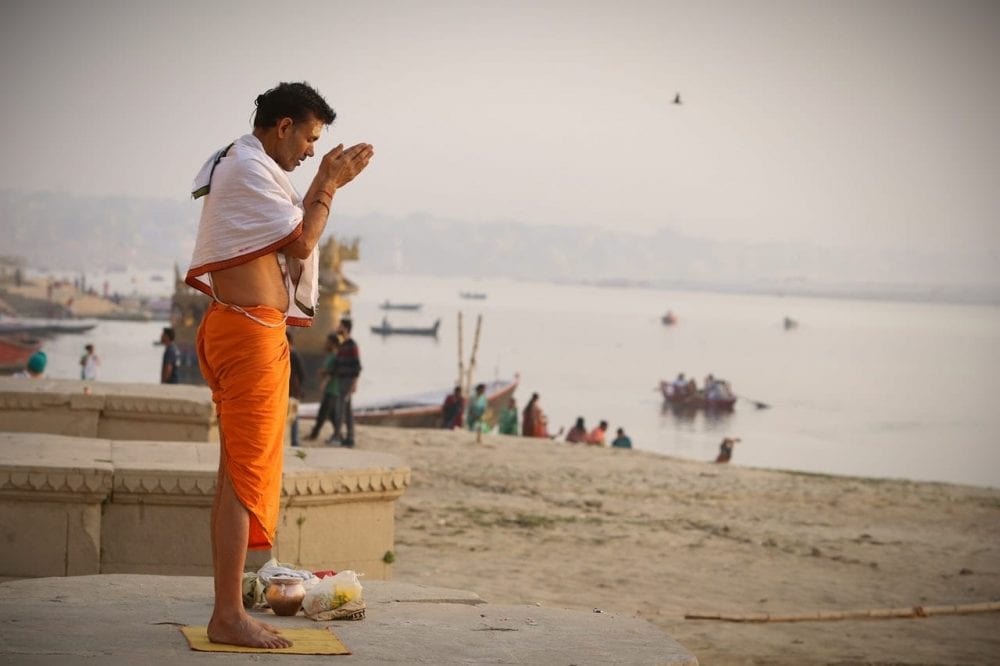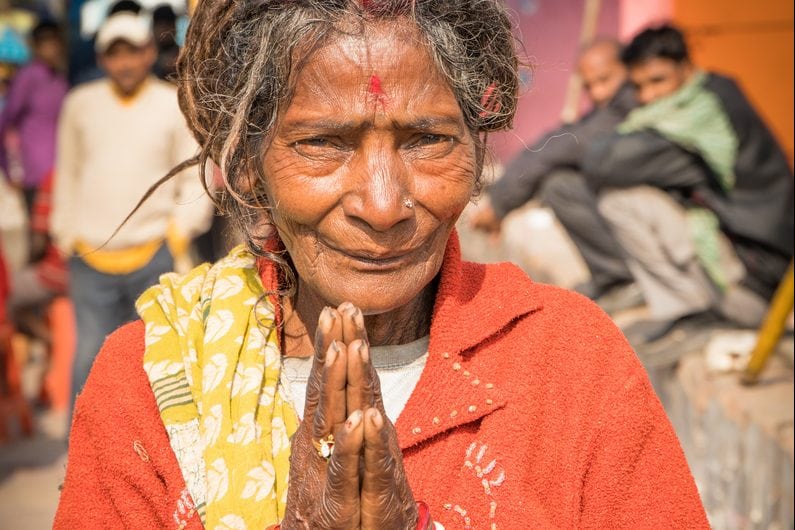

In this lesson, we differentiate cultural appropriation from cultural exchange and explain the significant reasons for honoring the roots of yoga.
Objective
Be aware of what cultural appropriation looks like; the historical context that explains the significance of honoring the roots of yoga; and how to mindfully and ethically do so.
Description
Define cultural exchange and cultural appropriation, and explain the key differentiators between them. Describe the vital significance of the roots of yoga and what appropriation of yoga looks like. Discuss commodification and elitism, and what you can do in response.

To understand cultural appropriation and its harm, we begin by understanding cultural exchange or cultural diffusion:
Cultural appropriation is much different from a respectful exchange:
Experts suggest that the key differentiator between cultural exchange and cultural appropriation is respect that results in:
Harming or Taking vs. Giving Back & Uplifting
The main difference between cultural appropriation and cultural appreciation is connected to 1) Power 2) Harm… Cultural appreciation seeks to connect with cultures different from one’s own from “the inside out.” It respects the codes, mores, values, and practices of the culture. Cultural appreciation can happen when one enjoys or respects the culture of origin and, instead of harming or taking, gives back and uplifts the source culture… Cultural appreciation involves power balancing and ahimsa (non-harm or harm reduction.) – Susanna Barkataki link
Movement of Elements From One Culture to Another as a Force for Good
By and large, the movement of artistic, scientific, and spiritual elements from one culture to another has been a force for good throughout history. And when you study the overall impact of India’s spiritual wisdom on America, as I have, you can only conclude that the benefits have been spectacular. – Philip Goldberg link
Equality & Respect
There needs to be some element of mutual understanding, equality, and respect for it to be a true exchange… Cultural exchange is engaging with a culture as a respectful and humble guest, invitation only. – Jarune Uwujaren link
Dominant Group Benefits; Origins & Meaning “Erased”
[Cultural appropriation is] a process that takes a traditional practice from a marginalized group and turns it into something that benefits the dominant group – ultimately erasing its origins and meaning. – Maisha Z. Johnson link
Exploitation & Cherry-Picking
I’m not saying that yoga is only for Indians (that’s not the case at all!) or that it should never be a workout. But… it disheartens me that much of the marketing around yoga has made it so that the entire point of the practice is often misunderstood. Cultural appropriation is when borrowing and sharing between cultures becomes exploitation. It’s cherry-picking what looks cool in a cultural practice without learning and acknowledging its complex history. – Puravi Joshi, Yoga Journal, The True Meaning of Yoga – Thoughts from a British Indian Yogi
Demanding Assimilation While Taking What is Wanted
Westerners are used to pressing their own culture onto others and taking what they want in return. We tend to think of this as cultural exchange when really, it’s no more an exchange than pressuring your neighbors to adopt your ideals while stealing their family heirlooms. True cultural exchange is not the process of “Here’s my culture, I’ll have some of yours” that we sometimes think it is. It’s something that should be mutual… The fact is, Western culture invites and, at times, demands assimilation. Not every culture has chosen to open itself up to being adopted by outsiders in the same way. – Jarune Uwujaren link
Dominant Group Exploits Target Group
Cultural appropriation is when someone uses someone else’s culture, including practices, symbols, rituals, fashion, or other elements from a target or “minority” culture, without considering the source, origins or people of that culture… Cultural appropriation happens when a dominant group adopts, benefits from, shares and even exploits the customs, practices, ideas, social and spiritual knowledge of another, usually target or subordinate, society or people. Cultural appropriation clearly harms the source culture in a variety of ways. – Susanna Barkataki link

The following readings point to the vital significance of the history and roots of yoga, particularly the integrity, resilience and courage of the people who preserved yoga despite efforts to violently annihilate the teachings and those who shared them.
Violent, Crushing Annihilation
The British attempted to wipe out Ayurveda in India during colonial rule. “Officers would chop off three fingers on Ayurvedic doctors, so they couldn’t do pulse diagnosis and, after the British left India, Ayurveda was nearly wiped out,” claims Will. That history looms so closely for anyone of Indian origin — and it’s why it feels so deeply offensive to me to have anything Indian appropriated in this country. This colonisation of wellness also extends to the removal of anything secular or ‘offensive’ to the Western sensibility. “I know an Indian yoga teacher who teaches at a studio where they are not allowed to use Sanskrit or chant ‘Om’ in their classes,” says Ravi. “If you are a studio owner and you feel like this about yoga, you should just call it an exercise class and run a fitness studio instead.” – Anita Bhagwandas link
Resilient People Preserved Yoga Despite Efforts to Eradicate It
The British used violence, rape, and murder to take control of the South Asian sub-continent — and they approached yoga with violence, too. They forced people to convert to Christianity, and outlawed the healing and spiritual practices seen as “primitive” traditions, like yoga. So how did South Asian people preserve yoga through all of that? With incredible resilience — and also by taking huge risks, with many of them losing their land and their lives. With yoga being so popular these days, it’s hard to imagine having to go through all of that just to practice it… After being demonized as a “savage” characteristic of the cultures of people of color, yoga was then repackaged in some schools as something white people could enjoy for entertainment and competition’s sake. [While] South Asians… [were] mistreated [for] following their cultural traditions… white people gain profits, attention, and credit for using diluted versions of the same practices. – Maisha Z. Johnson link
A Response to the Accusation of “Meaningless Whining’
Many forms of yoga cultural appropriation are subtle; they involve knowingly glamorizing a cultural practice, and rationalizing doing so as harmless and fun. There are many who claim that cultural appropriation is meaningless whining from non-white people. What these claims refuse to recognize is that many non-white cultures are still fractured or repairing themselves, facing continued prejudice in the present day. Rejecting cultural appropriation as a problem also rejects that many communities, often non-white ones, have been historically oppressed, colonized, and had their cultures ransacked for profit. – Puravi Joshi, The True Meaning of Yoga – Thoughts from a British Indian

What does cultural appropriation of yoga look like?
Phillip Goldberg explains here that appropriation is defined by qualities that are different from “political correctness run amok.” Cultural appropriation of yoga occurs when the deep, profound and sacred legacy of yoga is:
And Maisha Z. Johnson offers excellent coverage of this vital topic here. She presents the following “signs of cultural appropriation to watch out for” and supports them with meaningful depth.
Racist Double Standards
It can be frustrating and hurtful for people of color or other religions to see a few elements of their religion and culture adopted by white westerners while they still continue to face discrimination or are pressured to conform to the dominant culture in most aspects of their daily lives. If you were teased as a child, for example, for bringing curry to school in your lunchbox, it might not sit well to see a non-Indian pop star sporting bindis or wearing a sari outside the settings or occasions when someone of an Indian background would. – Meghan O’Dea link

Examples of appropriation in the form of “commodifying wellness” are rampant. Arguably, modern day society is dominated by greed and profit-seeking without ethical boundary; virtually everything, no matter how sacred, can be shown to be monetized and commodified by someone somewhere.
Selling a Harmful Perception: Only the Rich Get a Wellness Lifestyle
The Western world takes these practices and glorifies them into a narcissistic version. You don’t see the Indian, African, Asian or Latino person represented at all. And sadly, most spokespeople fit the “wellness white girl” stereotype – we rarely see people who look like shaman Durek; a loin-clothed Indian yogi; the fifth-generation Chinese acupuncturist; or a real Buddhist monk, giving us time-honoured advice. Instead, they’re embodied by women such as Gwyneth, founder of lifestyle brand Goop and, more recently, target of online ire for her claim to have popularised yoga (in a recent interview she said: “I went to do a yoga class in LA and the 22-year-old girl behind the counter was like, ‘Have you ever done yoga before?’ And I was like, ‘You have this job because I’ve done yoga before.’”) For me, that’s one of the biggest issues with commodifying wellness – who it’s been taken from, and who it’s being marketed to… While yoga doesn’t belong to Gwyneth, wellness is becoming elitist because of the people it shuts out. Shaman Durek says: “It’s made to seem like wellness comes from the upper classes and that you have to be rich to live this lifestyle.” – Anita Bhagwandas link
First and foremost, address your impact not just your intention. Consider whether your actions may be causing harm and try to reduce that harm. – Susanna Barkataki link
For those who wish to honor yoga and the people who have kept it alive for our benefit, here are some values, principles and behaviors that can guide your choices, summarized from writings by Susanna Barkataki and other experts:
Actively Centralize Those Who Have Been Previously Omitted
We South Asians, Indians and desi’s are here. Include us. Centralize us. Ask us. Invite us in. Lift us up. Historical oppression and omission have often decentralized us from a voice that should be ours to share. Include us and know there’s room for you in the circle and in the practice. – Susanna Barkataki link

A key example of appropriation is the presentation of yoga as a watered down or inaccurate version of its true essence and scope. We each have the ability to make a difference in this dismaying situation of being associated with a field that includes many inadequately trained “teachers.” We can do this by:
If you experience or have personal knowledge of abuse, dishonor or any malevolent actions, consider your response.

Use these readings as inspiration for investigating more deeply, and for learning about experts in the field you can follow up with:
Respect
Where do we draw the line between “appropriate” forms of cultural exchange and more damaging patterns of cultural appropriation? To be honest, I don’t know that there is a thin, straight line between them. But even if the line between exchange and appropriation bends, twists, and loop-de-loops in ways it would take decades of academic thought to unpack, it has a definite starting point: Respect. – Jarune Uwujaren link
Presented in all its Profound Depth and Fullness
Bear in mind that the Western absorption of yoga is not exactly comparable to colonial invaders stealing a subjugated country’s resources and rewriting its history. India suffered mightily from such violations for hundreds of years, which makes Indian sensitivity to appropriation more than understandable. For the most part, however, yogic treasures were not swiped like artwork from pillaged temples. They came with gurus, swamis, and yoga masters bearing gifts, and those respected emissaries saw only good in the transaction. Moreover, they showed us how to adapt their teachings to the languages, values, and customs of the West. They trained Americans and Europeans to teach others and empowered them to represent their lineages. Most of the gurus took flak for this from traditionalists…. Look beyond the trendy yoga studios at the older lineages, and you’ll see that they’re represented — and in many cases, led — by Westerners who revere India, consider it their spiritual home, and do their best to treat its spiritual traditions with dignity and respect. All that having been said, it bears repeating that cultural appropriation is a real phenomenon; it’s offensive, hurtful, and in some instances destructive… To me, what matters most is that yoga is presented accurately, with dignity, in all its profound depth and fullness. – Philip Goldberg link
Example: Deity Teachings
Sadly, it is an all too often occurrence for a teacher or student to transpose their own feelings and attitudes upon the devas, to present the deity in a form that is not really part of the tradition or teachings and in extreme cases has no connection with what the actual deity represents. Oftentimes, practitioners are not taking the time to understand that limited views hide a much deeper teaching and application of the teachings and, as a result, the devas are often reduced to an anthropomorphic quality akin to human emotion within the minds of students. It has become acceptable to use the pictures of deities for marketing purposes, to give a visual statement of how spiritual one is, in reality deities are not for marketing purposes, or something ‘cool’ to place on one’s website. This commercialism of deities increases the potential for readers to become confused as to what the deities represent, their role, and relevance they have within each practitioner’s life, and more importantly, the cosmic roles they play within creation. The Hindu deities represent a wide range of cosmological forces ranging from one’s own mind to the forces that shaped the universe. Hence the deities of Sanatana Dharma deserve respect, and a lack of respect indicates a lack of respect for oneself and others, in my opinion. – Yogi Baba Prem link
Becoming a “Yoga Teacher” in Three Weeks
Ravi Dixit, an Indian yoga teacher in west London, says, “You can find yoga training led by teachers who’ve never been to India or don’t really understand the basics, like the Sutras of Patanjali or the Eight Limbs of Yoga. There are online courses to become a yoga teacher in three weeks. It takes years of study to master it all – how is that possible in three weeks?” – Anita Bhagwandas link
Educate Yourself on the Forces that Have Attempted to Annihilate Yoga
To the so many white people who practice yoga, please don’t stop, but please do take a moment to look outside of yourself and understand how the history of yoga practice in the United States is intimately linked to some of the larger forces of white supremacy. – Shreena Gandhi & Lillie Wolff link
Honor Yoga’s Roots
Another powerful way to avoid appropriation is to honor yoga’s roots. Learn about the culture from the inside out. Explore the lineages. Explore the expanse of this practice far beyond just the physical. Read the sutras and cite sources of these wisdom teachings…Practice and teach as many of the limbs and other aspects of yoga as possible so we can experience the full range that yoga has to offer… Make sure, if we are using images of deities or regalia such as statues, malas or bindis, that we know where they came from, what they mean, how to relate to them respectfully and have a sincere intention at heart. Deepening our relationship is often so key. – Susanna Barkataki link
When Money is Prioritized Over Integrity
Will Williams, the founder of Beeja meditation centre in London, says, “It’s not a bad thing that people are trying to help others and share knowledge, but when money is prioritised over the wellbeing, integrity or history of a practice, there has to be a dedication to that culture.” – Anita Bhagwandas link
Honor the Lineage by Teaching Respect for It
Honor our lineage. Imagine if at the beginning of a yoga class teachers shared, “This is who I am, this is how I learned, I have a lot of respect for the lineage…” – Susanna Barkataki link
Example of Incorporating Honor into a Studio Model
One brand that I believe has the balance right is Triyoga, a yoga business with five London locations. “The origins of yoga are very important to us. We have visiting philosophy teachers, as well as specialist training for our staff. We do kirtan [chanting] in four of our centres; in our training, there are modules on philosophy and the history of yoga, and we host yearly fundraisers for the Odanadi Foundation [against human trafficking] in Mysore and the preservation of ancient manuscripts,” says Jonathan Sattin, MD of Triyoga. They’re mindful of making sure it’s for everyone – not just the wellness elite – offering discounts for seniors, students and people who are unemployed, as well as weekly half-price community classes. They also have yoga classes for refugees and yoga for cancer patients, both of which are free. But Jonathan says that it’s wider than that: “We’re trying to get this right – and we know there’s more to do – so the pictures on our website and the teams we hire are inclusive of race, sex, age and sexual preference. People are wary of going into a yoga studio for a number of reasons or preconceptions, and we want to break that down because we believe yoga is for everyone.” I’m not saying that being ‘wellness woke’ is easy – it involves research to have your eyes fully open. – Anita Bhagwandas link
Hindus Standing Against Adharma
Hindus have a duty (dharma) to stand up against the misrepresentation and misappropriation of Hinduism or Sanatana Dharma, and a duty to stand for dharma in general. The Vedas teach and support the concept of standing against adharma. It is clear that drifting away from dharma is a compulsion for a segment of human society…. It’s quite apparent these problems have plagued Hinduism for untold millennia, the difference being in the previous ages, there have been those that stood up for dharma and embraced their sacred duty. For our current age, this concept was reintroduced by Acharya Vamadeva Shastri (David Frawley) a considerable time ago as a call for an ‘intellectual kshatriya’ to rise up to defend Hinduism. But all too often the ‘intellectual Kshatriya’ has fallen into the trap of constant debate with other Hindus over subtleties of the tradition, yet these same intellectuals cower away when facing opposition from someone actually disrespecting Hinduism or attempting to harm the practitioners. The key is in the unification of practitioners of the expansive number of different traditions joining and standing together against the flagrant disrespect of teachings and traditions of Hinduism…. Hindu’s can… boycott companies that belittle Hinduism. Hindus can announce their intent by writing to webpages and magazines, or post comments requesting that articles that misrepresent Hinduism be removed. There is much that Hindu’s can do that requires a minimal amount of time, yet can make a significant difference. – Yogi Baba Prem link
